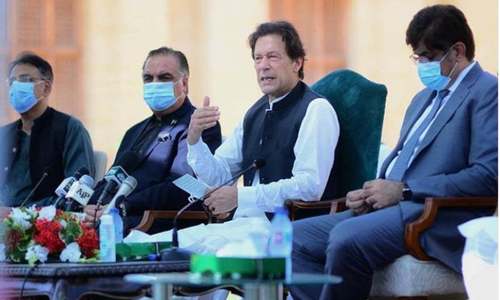KARACHI: A substantial chunk of Chinese development financing under the China-Pakistan Economic Corridor (CPEC) consists of loans that are at or near commercial rates as opposed to grants, according to a report released on Wednesday by AidData, a US-based international development research lab.
Shedding light on Beijing’s global development programme, the report said Chinese loans under CPEC constitute 95.2 per cent and 73pc of total commitments in energy and transport sectors, respectively.
China committed $34.4 billion in development finance to Pakistan between 2000 and 2017. Islamabad is the seventh largest recipient of Chinese overseas development financing with 71 projects worth $27.3bn currently under way. The interest rate is 3.76pc for an average loan with 13.2 years’ maturity (when full repayment with interest is due) and 4.3 years of grace period, it said.
PM’s aide claims all corridor projects transparent, involve zero hidden loans
In addition, the report claimed Pakistan received about half of all Chinese development finance in the form of “export buyer’s credit” i.e. money lent by Chinese institutions to Pakistan in order to facilitate the purchase of equipment and goods to be bought by Chinese implementation partners.
As much as 40pc of China’s lending to Pakistan is now directed to state-owned companies, state-owned banks, special purpose vehicles, joint ventures and private sector institutions. These Chinese loans do not appear on the government’s books “for the most part”, the report claimed.
“However, they often benefit from an explicit or implicit form of government liability protection, which blurs the distinction between private and public debt,” it said, noting that the government has issued sovereign guarantees in some cases. This means the national exchequer will repay the loans if non-government borrowers fail to generate sufficient revenue to meet their financial obligations.
“In other cases... the government has provided a so-called guaranteed return on equity to borrowers. This type of guarantee is effectively a form of hidden debt to China... These financial arrangements are attractive to the government because they need not be disclosed as public debts,” the report said, adding that the economy is already in the “danger zone” based on the public debt-to-GDP ratio of 92.8pc.
Responding to the criticism that Chinese investments constitute a hidden debt for the government, Special Assistant to the Prime Minister (SAPM) on CPEC Affairs Khalid Mansoor said all CPEC projects are fully transparent and involve zero hidden loans.
“All projects are Nepra (National Electric Power Regulatory Authority) approved. Everything is in the open. Nepra and NHA (National Highway Authority) websites show capital costs of all projects, including Chinese financing. There’s no hidden debt,” he said.
China outspending US
Post-CPEC, China is outspending the United States in Pakistan by 8.4 times as opposed to only 0.68 times in 2002, the report said. While Chinese financing has mostly been in hard infrastructure sectors like energy and transport, US assistance in the same period has focused more on civil society, social infrastructure, education, etc. “Even at the height of Pakistan’s crippling energy crisis during the mid-2010s, only around 10pc of US development assistance to Pakistan was in the energy sector,” the report said.
Mr Mansoor said the country is “leveraging China’s expertise in agriculture and IT sectors” after the recently held 10th Joint Cooperation Committee (JCC) meeting. “We’re setting up new research centres for agriculture. We’re going to improve our yields and seed quality with the help of Chinese. We are about to start work in a focused manner in many different areas,” the SAPM said.
Focus on Balochistan
The report noted Chinese investments were concentrated in Punjab until 2013. But they became more balanced across the four provinces mainly because of “fresh spending in Sindh during the Sharif years”. Almost 59pc of energy spending went to Sindh versus 10.6pc to Punjab between 2014 and 2017. “Balochistan has received only a small proportion of CPEC projects,” it said.
“Their information is not up to date. Our maximum focus is on Balochistan. The western route being developed under CPEC will benefit the most impoverished and far-flung areas of the province. Gwadar is witnessing huge development and a marketing plan is being devised to further develop the Gwadar Port,” Mr Mansoor said.
Published in Dawn, September 30th, 2021



































